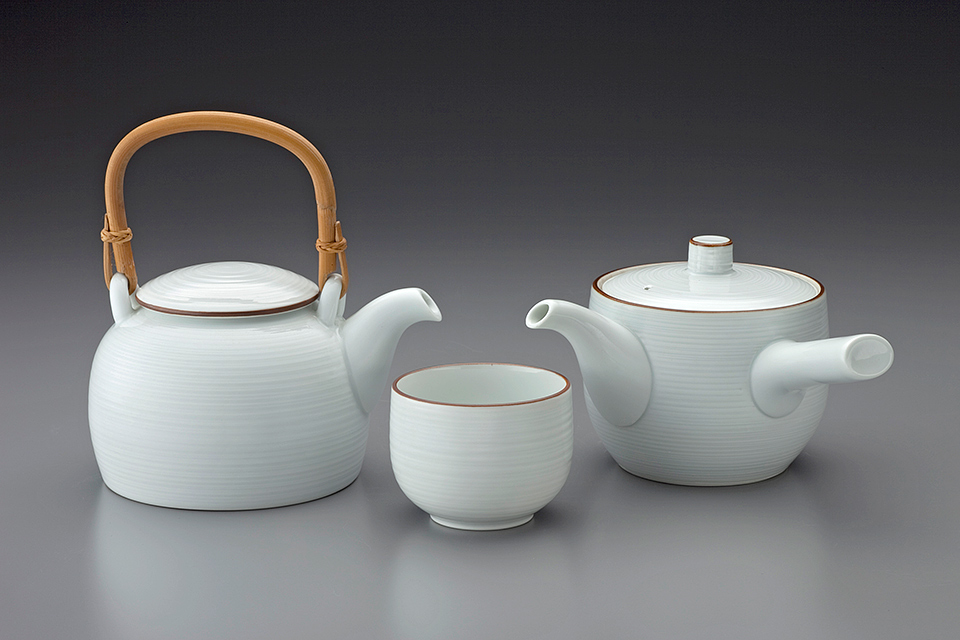Kyūsu on:
[Wikipedia]
[Google]
[Amazon]

 A is a traditional Japanese
A is a traditional Japanese
File:Kuroda Koryo - Teapot for Steeped Tea - Walters 49891 - Profile.jpg, ''Kyūsu'' teapot for steeped tea inscribed with a ''

 A is a traditional Japanese
A is a traditional Japanese teapot
A teapot is a vessel used for steeping tea leaves or a herbal mix in boiling or near-boiling water, and for serving the resulting infusion which is called tea. It is one of the core components of teaware. Dry tea is available either in tea ba ...
mainly used for brewing green tea
Green tea is a type of tea that is made from '' Camellia sinensis'' leaves and buds that have not undergone the same withering and oxidation process which is used to make oolong teas and black teas. Green tea originated in China, and since the ...
.
The common misconception is that a ''kyūsu'' always has a side handle. However, the word "kyūsu" merely means "teapot", even though in common usage ''kyūsu'' usually does refer to a teapot with a side handle.
The two most common types of ''kyūsu'' are , which has a side handle and which is the more common type, and , which has a rear handle, just like teapots in other parts of the world; there are also .
Tokoname ware
is a type of Japanese pottery, stoneware, and ceramics produced in and around the municipality of Tokoname, Aichi, in central Japan. Tokoname was the location of one of the Six Ancient Kilns of Japan.
History
Pottery made in Tokoname dates b ...
is known for its ''kyūsu''. In smaller types, some of the lids can be crafted in such a way that they will not fall off due to water adhesion
Adhesion is the tendency of dissimilar particles or surfaces to cling to one another ( cohesion refers to the tendency of similar or identical particles/surfaces to cling to one another).
The forces that cause adhesion and cohesion can be ...
. The spout also has to be crafted with an angle that no drops will leak back from it while pouring.
waka
Waka may refer to:
Culture and language
* Waka (canoe), a Polynesian word for canoe; especially, canoes of the M─üori of New Zealand
** Waka ama, a Polynesian outrigger canoe
** Waka hourua, a Polynesian ocean-going canoe
** Waka taua, a M─üori w ...
'' poem by ┼ītagaki Rengetsu
was a Buddhist nun who is widely regarded to have been one of the greatest Japanese poets of the 19th century. She was also a skilled potter and painter and expert calligrapher.
Biography
She was the daughter of a courtesan and a noblema ...
, stoneware with rice-straw-ash glaze, mid-19th century, late Edo period-early Meiji era
File:Aichi Prefectural Ceramic Museum 2018 (135).jpg, ''Kyūsu'' tea pot with sidehandle, design of landscape, underglaze blue, by Mizukoshi Yosobei in Kyoto, late Edo period or the early Meiji era, 19th century
File:Aichi Prefectural Ceramic Museum (75).jpg, ''Kyūsu'' tea pot, Tokoname ware
is a type of Japanese pottery, stoneware, and ceramics produced in and around the municipality of Tokoname, Aichi, in central Japan. Tokoname was the location of one of the Six Ancient Kilns of Japan.
History
Pottery made in Tokoname dates b ...
, Taish┼Ź era
The was a period in the history of Japan dating from 30 July 1912 to 25 December 1926, coinciding with the reign of Emperor Taish┼Ź. The new emperor was a sickly man, which prompted the shift in political power from the old oligarchic group of ...
ca. 1921-1925, by Yamada Jozan I
See also
*Japanese tea ceremony
The Japanese tea ceremony (known as or ) is a Japanese cultural activity involving the ceremonial preparation and presentation of , powdered green tea, the procedure of which is called . While in the West it is known as "tea ceremony", it is se ...
* ''Tetsubin
''Tetsubin'' (ķēäńōČ) are Japanese cast-iron kettles with a pouring spout, a lid, and a handle crossing over the top, used for boiling and pouring hot water for drinking purposes, such as for making tea.
''Tetsubin'' are traditionally heated o ...
'', a cast iron Japanese kettle
References
External links
Japanese tea Teapots Japanese pottery Japanese words and phrases {{drinkware-stub ja:µĆźķĀł